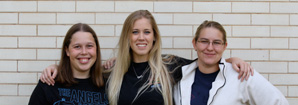Graduating Astronomy Major Research Symposium

On Thursday. April 24, at 3:45pm, a regular weekly research colloquium will be held, this time featuring four of our matriculating senior undergraduates. Lauren Biddle, Spencer Wallace, Amanda Walker-LaFollette, and Cassandra Lejoly will speak. Their abstracts are below. Please do join us. Pictured are Amanda Walker-LaFollette (left), Lauren Biddle (center), and Cassandra Lejoly (right). Not pictured, Spencer Wallace.
Lauren Biddle
--------------------
It is important to explore the diversity of characteristics of ice giants to understand the nature and evolution of this class of planets. We present a homogeneous analysis of 12 new and 9 previously published broadband photometric observations of the Uranus-sized extrasolar planet GJ 3470b, which belongs to the growing sample of sub-Jovian bodies orbiting M dwarfs. The consistency of our analysis explains some of the discrepancies between previously published results and provides updated constraints on the planetary parameters. Our data are also consistent with previous transit observations of this system. The physical properties of the transiting system can only be constrained as well as the host star is characterized, so we provide new spectroscopic measurements of GJ 3470 from 0.33 to 2.42 μm to aid our analysis. We also perform a second analysis of the transmission spectrum of the entire ensemble of transit observations to date, supporting the existence of a H2 dominated atmosphere exhibiting a strong Rayleigh scattering slope.
Spencer Wallace
------------------------
Current mixing length theories fail to properly address the interactions that occur between convective and stably stratified regions in stars. Purely local, static criteria such as Schwarzchild and Ledoux do not account for the mixing that occurs at the convective boundaries. We propose a dynamic boundary condition, based on the properties of the turbulent convective flow near the boundary, and describe how we implemented such a mixing mechanism in the MESA stellar evolution code. We also briefly consider how turbulence near the convective boundary affects semiconvective mixing.
Amanda Walker-LaFollette
------------------------------------
We conducted a survey of the 63 starless and prestellar cores in the Perseus molecular cloud to study the kinematics of the cores using the Arizona Radio Observatory 12m telescope. We observed the cores in HCN and H13CN and looked for blue asymmetry in the line profile, a sign of infall. We classified the line profiles based on whether there is a clear asymmetry or skew in the profile. Blue asymmetric infall profiles across an entire starless and prestellar core population are rare. Comparing to the number of class II protostars in Perseus we estimated the lifetime of collapsing prestellar cores to be (0.25 - 1.6)×105yrs, which is 0.74 - 4.7 times longer than the gravitational freefall time. This could indicate that some of the infall candidates are tracing larger scale flows.
Cassandra Lejoly
------------------------
I will present the periods of repeatability of individual coma features in Comet 1P/Halley measured using the position angle at different spatial distances from the nucleus in consequent cycles. I found that separate features appear to have different periods of repeatability within the same images, perhaps depending on the corresponding source regions on the nucleus. The periods of repeatability of coma morphologies will be presented as a function of time from the perihelion. I will also discuss the current work being done on the outflow velocities of the dust as well as the comprehensive modeling of the comet’s features.

For Public
Public events include our Monday Night Lecture Series, world-reknowned Astronomy Camp and Mt Lemmon Sky Center.

For Students
A good place to start if you want to become an undergrad major or grad student, or need to find our schedule of classes.

For Scientists
Find telescopes and instruments, telescope time applications, staff and mountain contacts, and faculty and staff scientific interests.




